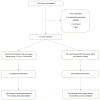Placental lesions in birth asphyxia and hypoxic ischemic syndrome
- PMID: 39624465
- PMCID: PMC11609886
- DOI: 10.3892/mi.2024.205
Placental lesions in birth asphyxia and hypoxic ischemic syndrome
Abstract
Birth asphyxia is a severe condition that includes a number of potential pathways of occurrence both in utero and during childbirth. The present study aimed to identify and describe specific macroscopic and microscopic placental injuries in birth asphyxia to serve as an effective tool to stratify the potential further evolution of a newborn, as hypoxic ischemic encephalopathy can be responsible for neonatal death or severe neurological sequelae further, compromising the quality of life of the affected individual. For this purpose, an observational prospective study was conducted over a period of 3 years. A total of 62 patients diagnosed with birth asphyxia, who had a placental histopathological examination performed were enrolled in the study. The control group consisted of 69 term newborns that required neonatal intensive care for at least 3 days, in the same time period, for any other reason and that also had available placental examinations. In the present study, placental histopathological lesions identified in birth asphyxia have been classified according to the Amsterdam Criteria. Data gathered from both groups were analyzed by applying specific statistical tests for each type of variable and hypothesis. Thus, umbilical cord abnormalities were associated with hypoxic ischemic encephalopathy in a statistically significant manner when comparing the birth asphyxia group of newborns with the control group. In addition, a high statistical level of significance was identified for microscopical lesions, such as maternal and fetal vascular malperfusion and the occurrence of hypoxic ischemic syndrome when comparing the two groups (P=0.01). The macroscopic and microscopic placental examination can provide critical information for the evolution of the disease in selected newborns according to the identified lesions.
Keywords: Amsterdam Criteria; birth asphyxia; hypoxic ischemic lesions; placental lesions.
Copyright: © 2024 Calomfirescu-Avramescu et al.
Conflict of interest statement
The authors declare that they have no competing interests.
Figures
References
-
- Ambalavanan N, Carlo WA, Shankaran S, Bann CM, Emrich SL, Higgins RD, Tyson JE, O'Shea TM, Laptook AR, Ehrenkranz RA, et al. Predicting outcomes of neonates diagnosed with hypoxic-ischemic encephalopathy. Pediatrics. 2006;118:2084–2093. - PubMed
-
- Volpe JJ. Neurology of the newborn. Edition 5. Saunders, PA, 2008.
-
- Avroy AA, Fanaroff JM, Klaus MH. Care of the high-risk neonate. Edition 6. Saunders, PA, 2013.
-
- Higgins RD, Raju TN, Perlman J, Azzopardi DV, Blackmon LR, Clark RH, Edwards AD, Ferriero DM, Gluckman PD, Gunn AJ, et al. Hypothermia and perinatal asphyxia: Executive summary of the national institute of child health and human development workshop. J Pediatr. 2006;148:170–175. doi: 10.1016/j.jpeds.2005.12.009. - DOI - PubMed
LinkOut - more resources
Full Text Sources


